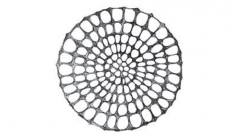

 Geodiversitas
31 (2) - Pages 271-356
Geodiversitas
31 (2) - Pages 271-356The catalogue of Mesozoic radiolarian genera is a revision of all described genera with re-illustration of their type species. This project was organized under the auspices of the International Association of Radiolarian Paleontologists (Inter- Rad), and was carried out by the Mesozoic Working Group. Th is is the second of two contributions, this one devoted to the Jurassic-Cretaceous period. It contains 581 genera with re-illustration of their type species. This part shares 30 genera in common with the Triassic catalogue, most of which arose in the Carnian, Norian and Rhaetian. The sharp difference manifested between the Triassic fauna and the Jurassic-Cretaceous fauna is so evident that it justifies two independent catalogues. A comparable division between the Jurassic and Cretaceous could not be justified however, because of the similarity of the fauna, and by the greater number of genera crossing the Jurassic-Cretaceous boundary which is three times that for the Triassic-Jurassic boundary. A distinct characteristic of Jurassic-Cretaceous genera is the high number of nomina dubia (up to 131), contrary to the low number in the Triassic interval. This refl ects, in part, the influence of Haeckelian taxonomy in earlier research on Jurassic- Cretaceous faunas prior to the application of SEM techniques.The Mesozoic Working Group has carefully reviewed and re-examined the taxonomy of all available genera, their family assignment and stratigraphic ranges. Following careful comparisons, 91 genera were declared as synonyms. The review has noted 26 homonyms which were duly notifi ed to their corresponding authors, and were corrected previous to the publication of this catalogue. In spite of this effort, unfortunately nine homonyms still remain. Two invalid nominal genera and two nomina nuda are also reported. The systematic revisions have validated 341 genera for the Jurassic-Cretaceous interval. At the end of this catalogue 24 additional photographs are presented as support for those genera having a poor original illustration of the type species.
Radiolaria, Jurassic, Cretaceous, systematic, type species, biostratigraphy